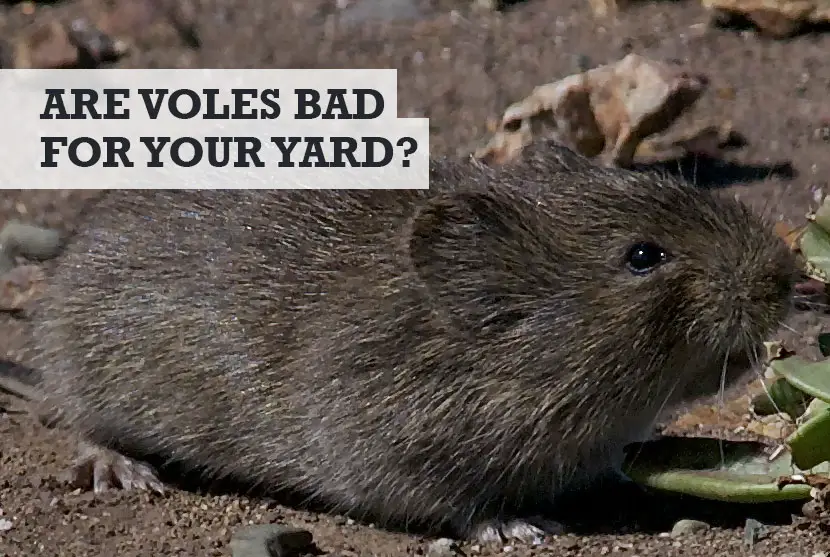This guide explains how voles can be bad for a yard and lawn, but also how they can damage a house. If you want the “too long, didn’t read answer” that’s below for you in bold.
However, if you want to know what the risks to you and your home are, and how to resolve it, read the guide in full.
Voles are bad for yards, gardens, and lawns as they dig holes meaning your well-kept yard could see dips developing when tunnels collapse. Voles also leave track marks on lawns which kills grass plus voles eat plants and bulbs. In rare cases they also cause house damage.
Sounds serious? Well, yes and no. Let me explain further…
Why voles are bad for your yard
Voles love digging holes, and if your yard is attractive to them with lots of food and places to hide, it won’t be long until they rock up and start multiplying. As well as the lawn damage and tunnels they can build which I discuss below, there are other “bad” things they can do to your yard.
Handy Hint: Read my guide to getting rid of voles in your yard.
One of the worst things voles do in yards is strip the bark from trees. Look out for patches where they have nibbled and chewed bark. If you’ve spent a lot of money designing your backyard space, you don’t want the expensive trees getting killed off. 1
You can protect trees in your yard from voles by wrapping tree trunk protectors (view on Amazon).
Voles are also bad for yards as one of their main food sources are bulbs. They will dig into planters and beds and start eating bulbs and root systems from the underneath. You won’t know they have started to kill your plants until it’s way too late.
What’s not often considered is how voles can spread disease and possibly introduce parasites to yards. According to the National Library of Medicine website, voles carry hantaviruses.
“Bank voles are hosts of Puumala hantavirus, which causes a form of hemorrhagic fever in humans. Selective predation by owls on infected voles may reduce human disease risk.”
A lesser consideration, but a more expensive problem to have, is how voles can cause patios and outdoor walls to collapse or become uneven. Admittedly, it’s not as common, but if you wanted one big reason why voles are bad for yards, this would be the one that would cost most to remedy.
For example, if you have rock wall used to retain part of the garden and yard landscape, vole tunnels beneath it can make it unstable. It’s not unheard of for garden walls to collapse due to voles digging.
Similarly, if voles dig tunnels under the patio in your yard, it’s bad. Once the tunnels collapse in, the pavers can become uneven and shaky.
Are voles bad for your lawn?
Voles are very good diggers and once they get into your yard, it won’t be long until you start to notice the damage to your lawn. The first thing to see will be the vole holes which are around the size of a golf ball (1.7 inches in diameter).
You will then notice tracks in the lawn, which are the vole runs from hole to hole. They will also leave their feces on the grass.

If left for too long and you don’t take steps to get rid of them, voles are very bad for lawns. The grass will start to die off where they have created tracks.
There’s also the risk of the vole tunnels collapsing. Because voles don’t dig too deep, only 12 inches maximum, it’s very easy to step on the grass above a tunnel and for it to collapse.
If left for too long, your garden lawn will develop dips and large patches of dead grass.
Are voles good for your lawn and garden?
Many people that say voles are not good for anything. They tend to be those that only care about their plants and yard… and that’s fine, I get it.
However, I want to redress some of this balance because voles do get a bad rep. There might be some cases when you welcome these small rodents into your backyard or garden…
For example, if you love seeing wildlife in your garden such as owls and foxes, then voles will attract them as prey. Voles can also help to keep certain insects and weeds in check.
The bottom line is that voles play an important part in a nature’s ecosystem. Because they are such prolific eaters of vegetation, it can stimulate the release of nutrients. There’s a great explainer on the Wisconsin Pollinators website.
“The impacts of meadow voles on their ecosystems are significant. Their high rate of ingestion of vegetable materials stimulates its decomposition and nutrient release. Their nutrient rich fecal pellets are widely dispersed through their habitats to the great benefit of new and growing vegetation. These voles also accelerate the dispersal of vital mycorrhizal fungi, and, thus, influence the survival and growth rates of many important species of trees.”
Are voles bad for your house?
Voles can be bad for your house, but the chances are slim that they will cause damage. Voles want to be outdoors where they can find food.
But that doesn’t that voles can’t cause house damage, they can occasionally. This can occur due to tunnels they have dug under a foundation or path, or in rare examples where they might get into your home.
How the damage might happen is when vole tunnels are created under the foundations of your home, or perhaps a patio and path area. This can create underground air pockets which could flood with water after heavy rain.
If the water cannot drain out properly, it might cause water damage to your home. The water could also freeze under the foundations causing structural damage. As I said though, this is rare, but it is still a possibility.
How voles cause house damage indoors
It’s very rare for voles to be found in your home, but that doesn’t mean they can’t cause house damage if they get in. You might find droppings and chewed house plants.
Voles don’t really want to be in your house. They would rather be outdoors in your yard where there’s an abundant food source readily available to them. If they have come indoors, it was likely by mistake.
Voles will make tunnels to find heat, get away from cold, and be hidden from their many predators. During the process of digging a tunnel in your lawn, they could end up coming into your home without intending to.
One example was in a friend’s backyard where a vole family had been digging holes in a lawn, then under a patio space, which eventually led them under and up into the floorboards of the house.
Voles are highly adept at digging and can create tunnels sometimes 12 inches deep. That’s deep enough to get under your house, and then possibly up and into it.
More backyard guides…
- How to get rid of vole holes in your yard
- The difference between chipmunk and vole holes
- Mole holes vs vole holes
Image of vole used in header via https://en.wikipedia.org/wiki/File:California_Vole_(Microtus_californicus)_(cropped).jpg


